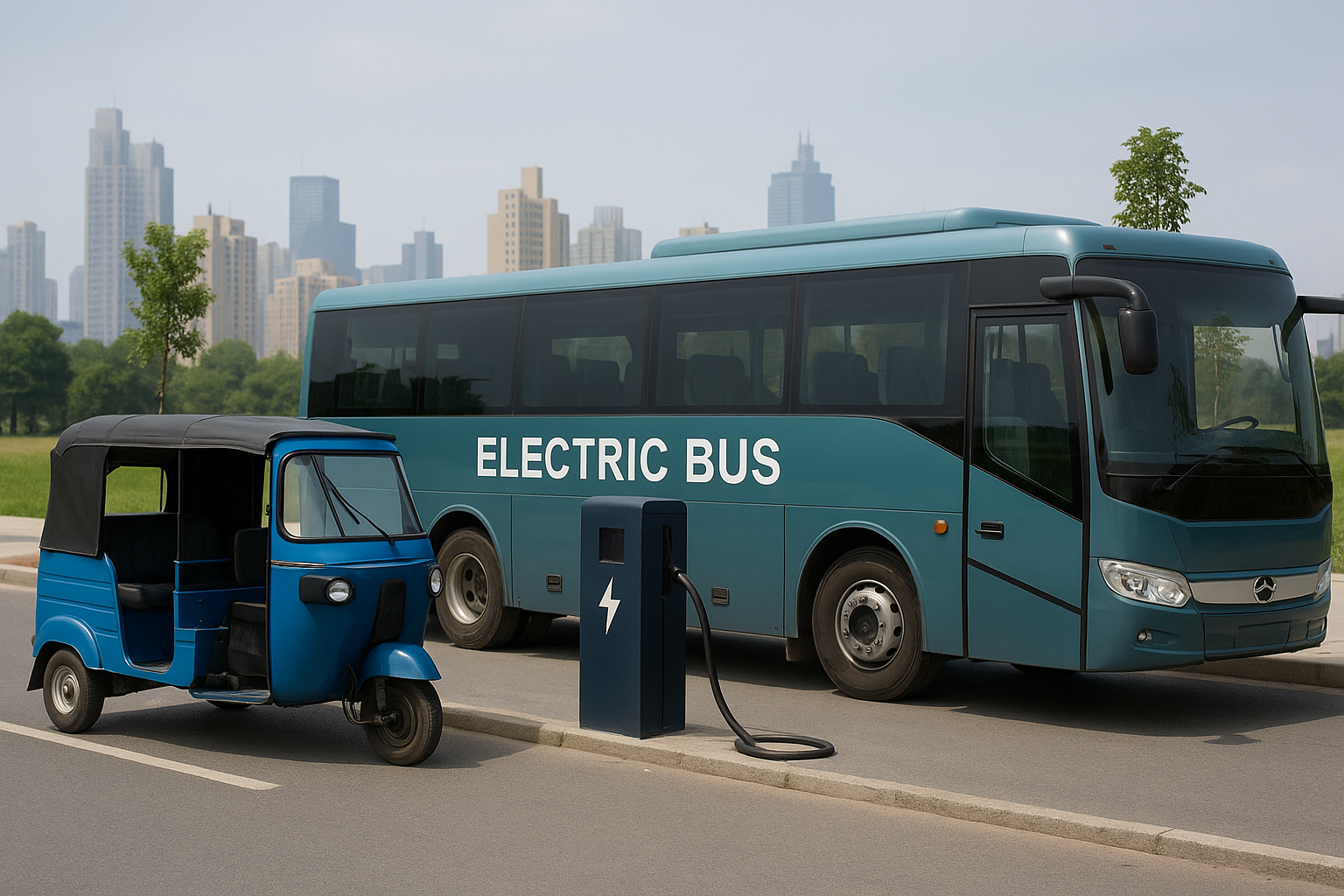Have you noticed something different on your daily commute lately? A quiet bus, a hum instead of a roar, or an e-rickshaw silently cruising past in traffic? That’s not a glitch in the matrix; that’s India’s electric vehicle (EV) revolution slowly coming alive.
While the global headlines rave about Tesla in the US or BYD in China, something incredible and quieter is brewing here in India. Long seen as a follower when it came to clean mobility, India is now emerging as an unexpected but determined EV player. And it’s not luxury sedans or private cars taking the lead; public transport sets the wheels in motion.
India Drives Down Costs and Emissions with Electric Public Transport
Public vehicles run longer distances, carry more people, and consume more fuel. Electrifying them first makes sense, economically and environmentally. Electric buses are already operating across major cities like Delhi, Bengaluru, Mumbai, and Pune. According to the Ministry of Heavy Industries, 6,315 electric buses were sanctioned under the FAME-II scheme. Over 4,900 are currently on the road.
Bengaluru Metropolitan Transport Corporation (BMTC) has over 1,000 e-buses. Delhi aims for an all-electric public transport fleet by 2030. Other cities are following similar paths. Diesel buses cost Rs. 100 to Rs. 120 per kilometre. On the other hand, electric buses cost only Rs. 10 to Rs. 12. Now scale that up over thousands of trips, and you start to see why cities are betting on electricity.
As Union Minister Nitin Gadkari said, “Electricity is not a luxury, it’s a necessity. For India, the economics of EVs make more sense than anywhere else in the world.”
EV Charging is Not as Complicated as It Seemsṣ
If you’re picturing rows of giant buses plugged into wall sockets, not quite.
Electric buses are usually charged at dedicated depots overnight using fast DC chargers. Some cities are trying out opportunity charging, where buses top up their batteries for 10–15 minutes at terminal stations between trips. It’s like giving your phone a quick boost while you sip chai.
A few depots in Himachal and Maharashtra have also gone solar. Panels line the bus roofs and depot shelters, creating a clean, closed-loop energy system. The FAME-II subsidy helps make this financially feasible.
Auto-rickshaws and electric three-wheelers are adopting another method, known as battery swapping. Instead of plugging in and waiting, drivers can pull up to a station, swap out a drained battery for a fully charged one, and be on their way in under 3 minutes. Companies like SUN Mobility and Battery Smart are leading the charge.
Still, swapping networks face challenges. Standardisation of battery types and consistent availability top the list. Industry leaders like SUN Mobility (partnering with Indian Oil) aim to tackle this with a 10,000-station network across 40 cities. As co-founder Chetan Maini puts it, “Swapping removes the two biggest barriers — high upfront cost and charging downtime.”
India’s Shift to Electric Public Transport Powers Cleaner Air and Greener Mobility Solutions
India’s electric public transport isn’t just good economics. It’s a climate imperative. With some of the world’s most polluted cities, shifting buses, autos, and taxis to electric power is essential.
According to Tata Motors, every electric bus on Indian roads can reduce CO₂ emissions by up to 1 lakh kg per year compared to diesel buses.
It’s not just the government that’s pushing this change. Ola and Uber are now integrating EVs into their fleets. Ride-sharing companies are signing green pledges, and delivery platforms are eyeing electric two-wheelers to cut last-mile emissions.
All this momentum creates a ripple effect, making EV technology more affordable, expanding the charging network, and pushing innovation at scale.
Public EV Push Powers Benefits for Private Buyers Too
The electrification of public transport is already benefiting the private market.
- More charging stations: Bus depots are often opened to private EV users during off-hours, and cities are expanding public charging points faster than ever.
- Battery costs are falling: Large-scale procurement of EVs is bringing down the price of lithium-ion batteries, reducing prices for two- and four-wheelers.
- Policy support grows stronger: As governments see public EVs succeed, they’re more willing to incentivise private buyers.
In fact, according to NITI Aayog, India’s goal is that 30% of all new vehicle sales by 2030 will be electric. Public transport is laying the foundation for that.
What Happens to Petrol and Diesel Cars?
Fuel prices remain high, maintenance is costlier, and EV resale value is rising. Governments are exploring congestion fees and low-emission zones in cities. ICE vehicles may face restrictions or higher ownership costs as these policies strengthen.
Private buyers will eventually have to decide whether to stick with familiar engines or switch to cleaner, cheaper, and increasingly more reliable EVs.
Public transport leads India’s EV shift as private owners follow
India’s EV revolution didn’t begin with private buyers or luxury cars. It started with buses, autos, and shared rides — vehicles that touch millions of lives every day.
Public transport is proving that electric mobility works. It’s cost-effective, scalable, and sustainable. The ecosystem is growing faster than many expected.For private ICE owners, the writing is on the wall. The road ahead is electric. The question is: When will you make the switch?
